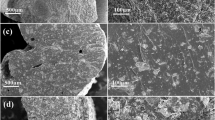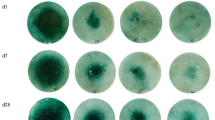Abstract
Urea release rates in water (38°C) and in a simulated wetland soil system under greenhouse conditions from silicate- and polymer-coated urea (SPCU) materials have been studied. The SPCU materials were prepared by the Korea Advanced Institute of Science and Technology (KAIST), Seoul, Korea, in cooperation with the International Fertilizer Development Center (IFDC). Average urea release (\(\overline {UR} \)) in water was mainly a diffusion-controlled, concentration-gradient dependent process. It was markedly influenced by the extent of swelling of the coatings of granules. Under unrestricted swelling condition,\(\overline {UR} \) versus time gave an s-shaped curve with three distinct periods: namely, a delayed period, a maximum-rate period, and slow-rate period.\(\overline {UR} \) versus time curves for SPCU after placement at 0- to 2-, 5- to 10- and 10- to 15-cm depth in a simulated wetland soil system were, in general, sigmoidal but different from those in water. They were influenced by placement depths of SPCU granules in the soil, and the order of\(\overline {UR} \) at the soil depths studied was: 0–2 cm, < 5–15 cm ⩽ 10–15 cm.
Similar content being viewed by others
References
International Fertilizer Development Center (IFDC) (1982) Annual report for 1981, Muscle Shoals, Alabama, USA
International Rice Research Institute (IRRI) (1979) Annual report for 1978, Los Banos, Philippines
International Rice Research Institute (IRRI) (1980) Annual report for 1979, Los Banos, Philippines
Korea Advanced Institute of Science and Technology (KAIST) (1979) Improving nitrogen fertilizer efficiency through controlled release with emphasis on urea, Final report phase I, Seoul, Korea (unpublished)
Korea Advanced Institute of Science and Technology (KAIST) (1980) Improving nitrogen fertilizer efficiency through controlled release with emphasis on urea, Final report phase II, Seoul, Korea (unpublished)
Onken AB and Sunderman HD (1977) Colorimetric determination of exchangeable ammonium, urea, nitrate, and nitrite in a single soil extract. Agron J 61, 49–53
Savant NK and De Datta SK (1979) Nitrogen release patterns from deep placement sites of urea in a wetland rice soil. Soil Sci Soc Am J 43, 131–134
Savant NK and De Datta SK (1980) Movement and distribution of ammonium-N following deep placement of urea in a wetland rice soil. Soil Sci Soc Am J 44, 559–565
Savant NK, Clemmons JR and James AF (1982) A technique for predicting urea release from coated urea in wetland soil. Comm Soil Sci. Plant Analysis 13, 793–802
Vlek PLG and Craswell ET (1979) Effect of nitrogen source and management on ammonia volatilization losses from flooded rice-soil systems. Soil Sci Sco Am J 43, 352–358
Vlek PLG, Byrnes BH and Craswell ET (1980) Effect of urea placement on leaching losses of nitrogen from flooded rice soils. Plant and Soil 54, 441–449
Young RD (1974) TVA's Developments of sulfur-coated urea. Bulletin Y-79, National Fertilizer Development Center, Muscle Shoals, Alabama, USA
Author information
Authors and Affiliations
Rights and permissions
About this article
Cite this article
Savant, N., James, A. & McClellan, G. Urea release from silicate- and polymer-coated urea in water and a simulated wetland soil. Fertilizer Research 4, 191–199 (1983). https://doi.org/10.1007/BF01053256
Issue Date:
DOI: https://doi.org/10.1007/BF01053256




